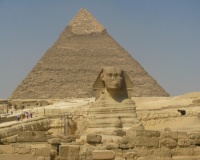Great Pyramid of Giza (2560 BC)
One of the Seven Wonders of the Ancient World[edit]
The Great Pyramid of Giza was constructed approximately between 2560–2540 BC in honour of the Egyptian king Khufu, and is thought to have been intended as his tomb. Even into the 19th century it remained the tallest building in the world, 147 metres, and it comprised of about 2.3 million stone blocks, weighing 2.5-15 tons each. This remarkable piece of engineering is the only one of the so-called ‘Seven Wonders of the ancient World’ to remain in tact, and has stood as an icon for ancient Egyptian culture for thousands of years. In addition, it continues to attract great numbers of people to explore contemporary, as well as ancient, Egyptian culture. Some controversy and disagreement remains over the precise purpose of the pyramid to ancient Egyptian culture, and how it was built, and has inspired countless experts and investigators from around the world for centuries. It demonstrates how collective marvel at a wonder of supreme significance to ancient culture and engineering may bring different cultures together to investigate the people and behaviours of the past.
